Cochiti Pueblo Wall Mounted Font with Deer Head by Louis and Virginia Naranjo - 25809
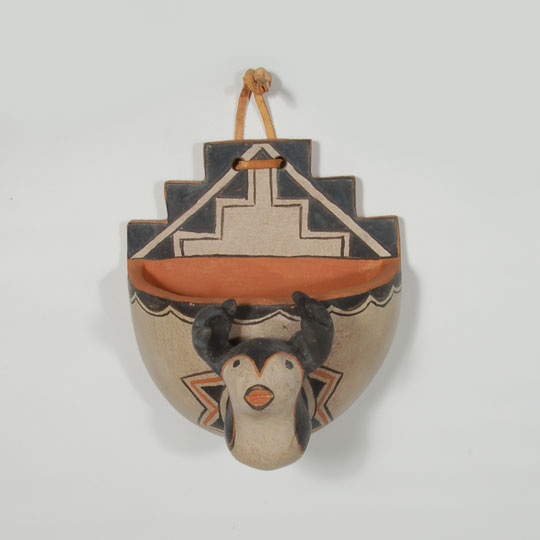 Louis and Virginia Naranjo were standard bearers for the proud figurative pottery tradition of Cochiti Pueblo. They crafted their figurines at the kitchen table in their comfortable adobe home at the pueblo. They worked almost every day crafting their art with great care, joking and exchanging the gossip of the day as they went along, accompanied by television, children and grandchildren. Their art provided a good life for them and it provided a legacy that will be with us for another century or more.
Louis and Virginia Naranjo were standard bearers for the proud figurative pottery tradition of Cochiti Pueblo. They crafted their figurines at the kitchen table in their comfortable adobe home at the pueblo. They worked almost every day crafting their art with great care, joking and exchanging the gossip of the day as they went along, accompanied by television, children and grandchildren. Their art provided a good life for them and it provided a legacy that will be with us for another century or more.
Louis was very creative in making items that differed from what other potters were making at the time. He and Virginia made large figurines of male and female tourists in bikinis, sunglasses, and with a camera hanging around their neck. He also dreamed up the black bear storyteller figurine as well as the Santa Claus figurine. Together they made mermaids and animals.
Oil Painting “Cottonwoods in Autumn” by Carl Von Hassler - C3647
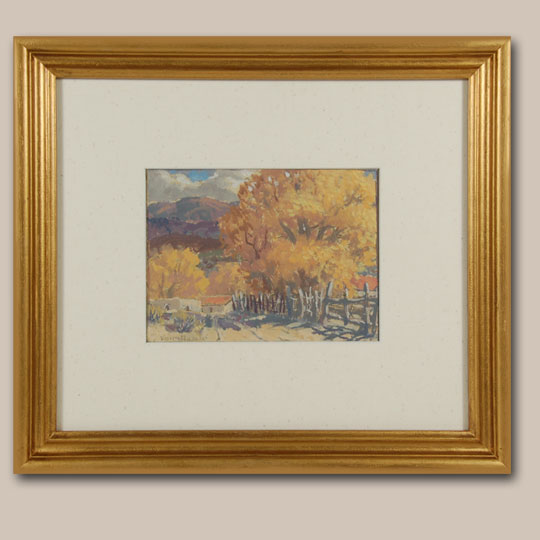 This is a small oil painting by Carl Von Hassler that was painted as a gift "To my dear friends Mr. & Mrs. G. Henderson." The artist drew a frame around the painting, in pencil, and wrote the dedication to the Hendersons below the lower edge of the painting. As currently seen, the mat covers the artist's hand-drawn frame and the dedication remarks. The mat could be enlarged should someone wish to display the hand-drawn frame and dedication line.
This is a small oil painting by Carl Von Hassler that was painted as a gift "To my dear friends Mr. & Mrs. G. Henderson." The artist drew a frame around the painting, in pencil, and wrote the dedication to the Hendersons below the lower edge of the painting. As currently seen, the mat covers the artist's hand-drawn frame and the dedication remarks. The mat could be enlarged should someone wish to display the hand-drawn frame and dedication line.
On the back of the painting, the artist wrote the following: "Cottonwoods in Autumn" by Von Hassler - 1952. Region - Velarde Valley near Taos Junction.
San Ildefonso Pueblo Pottery Jewel by Russell Sanchez - 25732
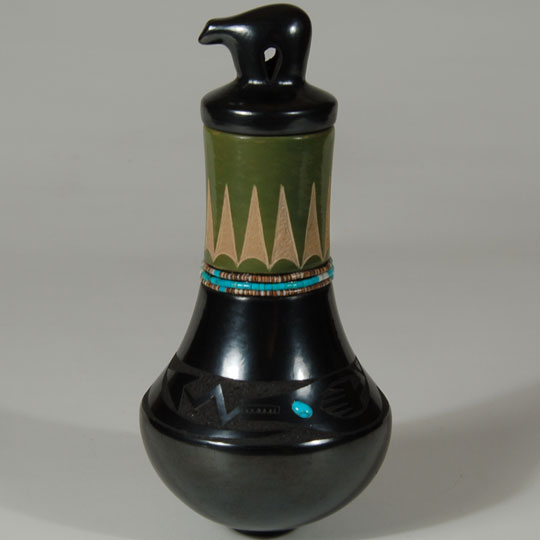 I doubt there is anyone who is not aware of just how talented Russell Sanchez is as an artist. He has been compared to other potters of earlier periods but his work is not like any others. He combines designs and vessel shapes of traditional Tewa Pueblos and enhances those shapes with slips and designs not traditionally used. This Southwest Indian Pottery jar is a vessel shape seen in works by other San Ildefonso Pueblo potters such as Maria Martinez and Rose Gonzales, but the comparison to these famous matriarch potters ends there.
I doubt there is anyone who is not aware of just how talented Russell Sanchez is as an artist. He has been compared to other potters of earlier periods but his work is not like any others. He combines designs and vessel shapes of traditional Tewa Pueblos and enhances those shapes with slips and designs not traditionally used. This Southwest Indian Pottery jar is a vessel shape seen in works by other San Ildefonso Pueblo potters such as Maria Martinez and Rose Gonzales, but the comparison to these famous matriarch potters ends there.
Historic Zuni Pueblo Olla with Heartline Deer with Heads Facing Rear - 25719
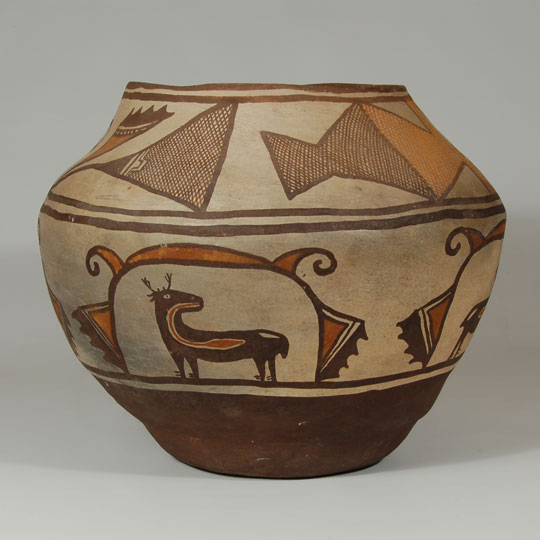 Heart-line deer first appeared on Kiapkwa Polychrome pottery in the 1840s but became more frequently seen in Zuni Polychrome jars of the 1880s and later. Often the animals represent elk or antelope. The animals are enclosed in houses with feather motifs decorating the exterior of the house. Most often, there is a red line extending from the mouth of the animal into the interior, a line referred to as the "breath of life" of the animal. The feet of the animal have one hoof above the other and often have a white area on the rump.
Heart-line deer first appeared on Kiapkwa Polychrome pottery in the 1840s but became more frequently seen in Zuni Polychrome jars of the 1880s and later. Often the animals represent elk or antelope. The animals are enclosed in houses with feather motifs decorating the exterior of the house. Most often, there is a red line extending from the mouth of the animal into the interior, a line referred to as the "breath of life" of the animal. The feet of the animal have one hoof above the other and often have a white area on the rump.
The animals on this jar follow the expected style seen on most Zuni Polychrome jars with the exception of the following: most animals face to the right but these face to the left and most animals face forward but these face to the rear. Is there any reason for these two changes? Probably it was only the desire of the potter to do something different from others being painted.
Historic Twentieth Century Acoma Jar with Tularosa Design - C3642H
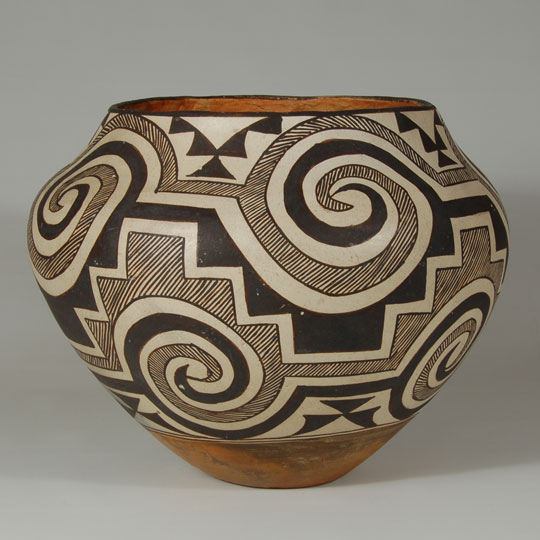 Acoma Pueblo potters have claimed the inherited right to use designs of the earlier Puebloan groups that lived in the early Southwest. The designs of particular striking beauty are those appropriated by 20th-century Acoma potters and referred to as Tularosa Black-on-white. The Tularosa vessels date from A.D.1100 to 1250.
Acoma Pueblo potters have claimed the inherited right to use designs of the earlier Puebloan groups that lived in the early Southwest. The designs of particular striking beauty are those appropriated by 20th-century Acoma potters and referred to as Tularosa Black-on-white. The Tularosa vessels date from A.D.1100 to 1250.
Acoma potters have been particularly involved with the use of these designs since the late 19th century.
The Tularosa Basin is located in the area east of the Rio Grande in southern New Mexico, mostly in Otero County. It lies between the Sacramento Mountains to the east and the San Andres and Oscura Mountains to the west. Notable features of the Tularosa Basin are White Sands National Monument, Trinity Site, and the Carrizozo lava flows.
Historic Monochromatic Design Polychrome Laguna Pueblo Olla - 22711
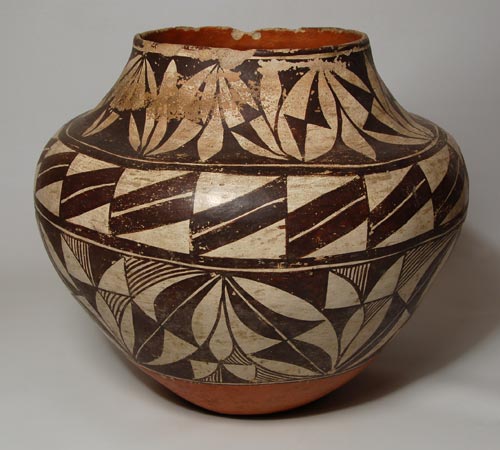 A polychrome olla of Laguna Pueblo origin, dating to circa 1900-1910. This piece is a superb example of pottery made solely for use within the Pueblo as a truly utilitarian vessel. This work was in fact purchased at Laguna, where it had been in the same family for at least three generations, seeing daily use as a vessel for storing water.
A polychrome olla of Laguna Pueblo origin, dating to circa 1900-1910. This piece is a superb example of pottery made solely for use within the Pueblo as a truly utilitarian vessel. This work was in fact purchased at Laguna, where it had been in the same family for at least three generations, seeing daily use as a vessel for storing water.
A fine visual statement, this vessel's design field is broken into three sections: mid-body, shoulder, and neck. The underbody and neck interior are slipped the typical orange-red, with a white, rag-wiped slip on the mid-body. The upper field is worked in black mineral pigments on white, with a lovely arrangement of white ellipses, split with an interior motif of bilaterally paired triangular elements, with white tear-drop motifs defining the space between each elliptical motif. The shoulder is worked with two bold, unbroken framing lines; the interior space activated by running split rectangles. The field at mid-body is defined with a series of ellipses, again with interior split curvilinear motifs, adjacent to block geometric and fine-line detailing.
Hopi 2nd Mesa Coiled Basket with Crow Mother Images - 25849
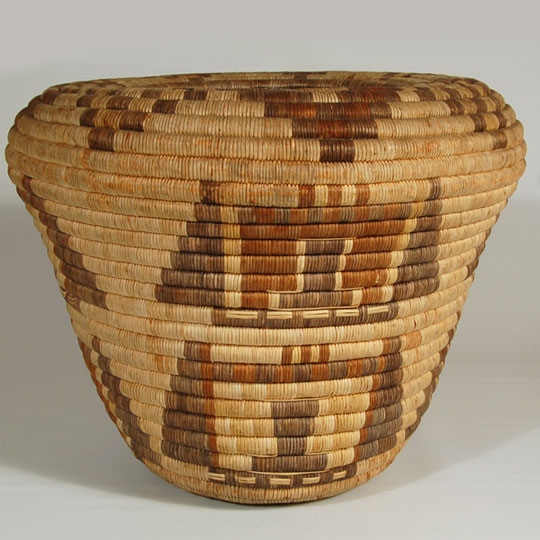 The Hopi Pueblo women of Second Mesa villages have been making coiled basketry for over a thousand years using the same materials and same techniques. None of the materials are from domesticated sources. They all are from wild plants. The leaf of the yucca plant is used for the weft design and grasses are bundled together for the warp foundation. The colors are limited to white, yellow, green, red and black. The first three colors are derived from the yucca leaves, the difference being in the time of year the material is collected. The rust and black colors are dyed yucca leaves.
The Hopi Pueblo women of Second Mesa villages have been making coiled basketry for over a thousand years using the same materials and same techniques. None of the materials are from domesticated sources. They all are from wild plants. The leaf of the yucca plant is used for the weft design and grasses are bundled together for the warp foundation. The colors are limited to white, yellow, green, red and black. The first three colors are derived from the yucca leaves, the difference being in the time of year the material is collected. The rust and black colors are dyed yucca leaves.
Kewa (Santo Domingo) Pueblo Turquoise and Shell Jaclas by Tina Montoya - 25814.2
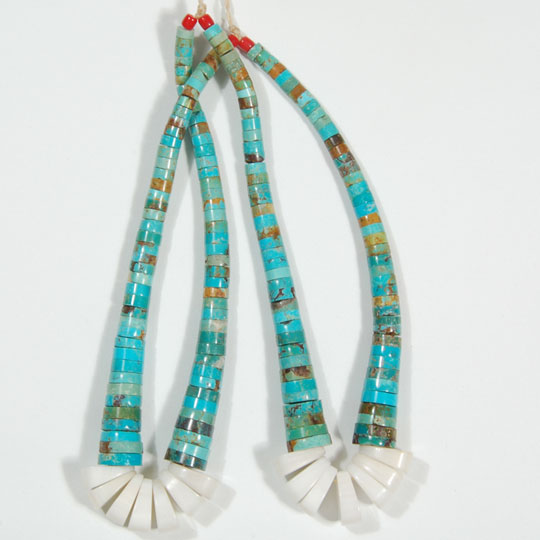 Jaclas are comprised of two loops of turquoise and shell strung individually and then tied together in a fashion by which they can be hung from a nugget necklace. Originally, in the 19th century, each of the units was made for use as earrings. When not being worn, they were hung on a nugget necklace for storage. Eventually, their use as earrings ceased and their use as a pendant on a necklace became permanent.
Jaclas are comprised of two loops of turquoise and shell strung individually and then tied together in a fashion by which they can be hung from a nugget necklace. Originally, in the 19th century, each of the units was made for use as earrings. When not being worn, they were hung on a nugget necklace for storage. Eventually, their use as earrings ceased and their use as a pendant on a necklace became permanent.
Historic Santa Ana Pueblo Dough Bowl, 1850-1900 - 25894
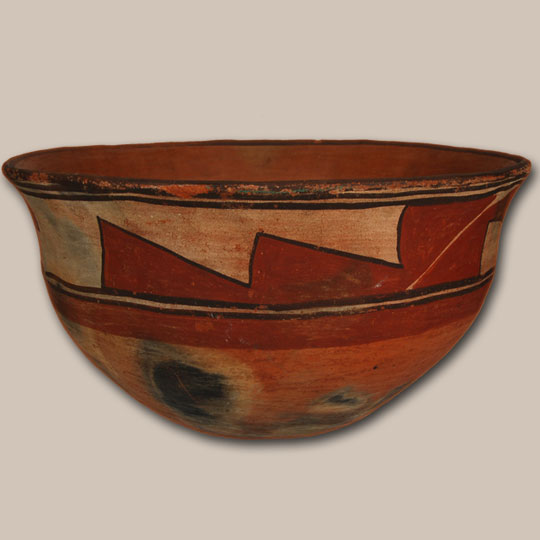 This Santa Ana dough bowl was originally in the Gallegos Collection which was sold in 1990 by Morning Star Gallery in Santa Fe. The collection was first published in a book entitled Two Hundred Years of Historic Pueblo Pottery: The Gallegos Collection with text written by Francis H. Harlow. The description by Harlow for this dough bowl is as follows:
This Santa Ana dough bowl was originally in the Gallegos Collection which was sold in 1990 by Morning Star Gallery in Santa Fe. The collection was first published in a book entitled Two Hundred Years of Historic Pueblo Pottery: The Gallegos Collection with text written by Francis H. Harlow. The description by Harlow for this dough bowl is as follows:
"Despite the general decline in pottery quality at Santa Ana after about 1850 there were, nevertheless, a few vessels made that exhibit surviving skill in at least a few of the potters. This bowl is a good example.
RARE Black-on-black Shallow Bowl with Birds signed Marie & Julian - C3591
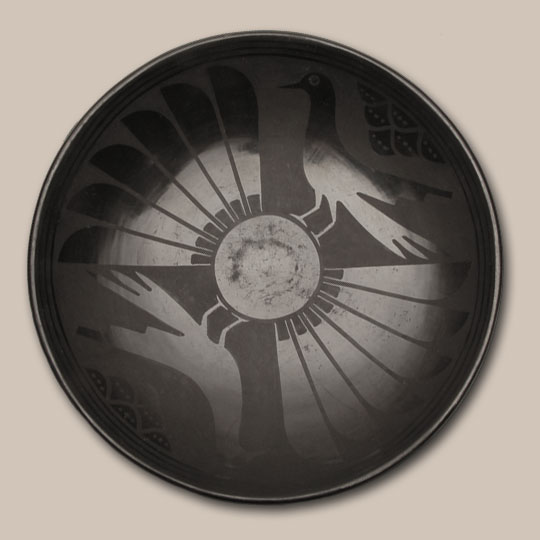 Maria and Julian were responsible for the revival of pottery production at San Ildefonso and largely responsible for the overall revival in interest in pueblo pottery from all pueblos. Maria was making beautiful pottery and Julian was adding to that beauty with his painting skills.
Maria and Julian were responsible for the revival of pottery production at San Ildefonso and largely responsible for the overall revival in interest in pueblo pottery from all pueblos. Maria was making beautiful pottery and Julian was adding to that beauty with his painting skills.
This shallow bowl features a combination of birds, rain clouds and eagle feathers in an almost identical arrangement as one in the Museum of Indian Arts and Culture which is dated circa 1940.
Young Diné Girl Sitting and Daydreaming Outdoors by Beatien Yazz - 25792
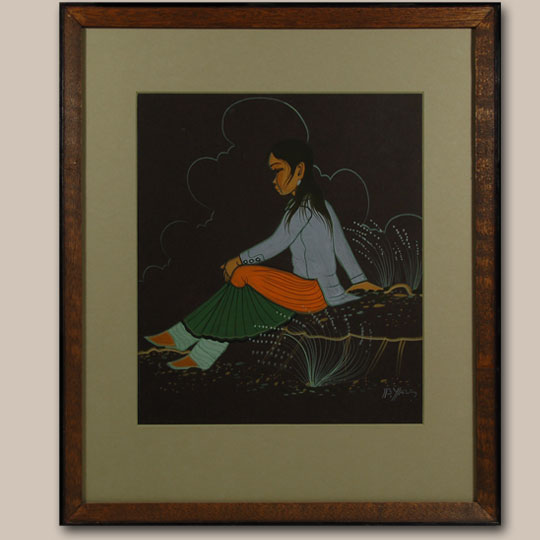 Beatien Yazz's paintings reflect his vision of reservation life, many of which include the activities of children and animals as well as Navajo ceremonies. For a time period his experiences with the Native American Church became the subject of some of his most interesting work.
Beatien Yazz's paintings reflect his vision of reservation life, many of which include the activities of children and animals as well as Navajo ceremonies. For a time period his experiences with the Native American Church became the subject of some of his most interesting work.
Beatien Yazz was born in 1928 on the Navajo Reservation and spent his whole life there. He showed promise as an artist very early. At an early age.
Young Diné Boy Sitting and Dreaming Outdoors by Beatien Yazz - 25793
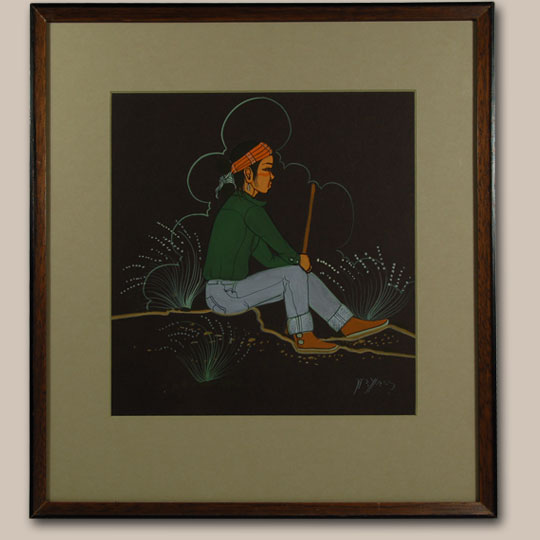 Most paintings by Beatien Yazz reflect the everyday lives of the Navajo. He has always been a master of detail; painting the special nuances that make reservation life unique. In the instance of this painting he is showing the innocence of youth. The young boy is dressed in traditional Navajo style, including moccasins and a headband. He appears to be enjoying the outdoors while daydreaming.
Most paintings by Beatien Yazz reflect the everyday lives of the Navajo. He has always been a master of detail; painting the special nuances that make reservation life unique. In the instance of this painting he is showing the innocence of youth. The young boy is dressed in traditional Navajo style, including moccasins and a headband. He appears to be enjoying the outdoors while daydreaming.
Navajo Traditional Ceremonial Basket - 25785
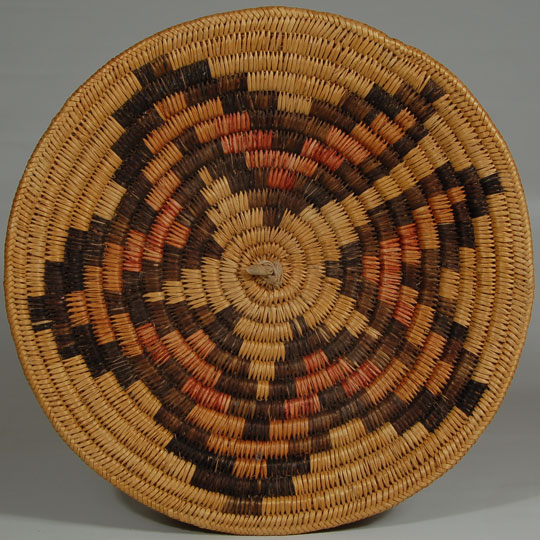 Navajo Ceremonial Baskets, commonly called Wedding Baskets, are constructed with a rod foundation of willow or sumac. The background or light color in the basket is natural sumac. The black and red are dyed. The black dye is derived from sumac leaves, twigs and berries crushed and boiled with a powder made from melted piñon and roasted ocher. The red comes from boiled mountain mahogany roots to which are added ashes of twigs of juniper and powdered bark of black alder.
Navajo Ceremonial Baskets, commonly called Wedding Baskets, are constructed with a rod foundation of willow or sumac. The background or light color in the basket is natural sumac. The black and red are dyed. The black dye is derived from sumac leaves, twigs and berries crushed and boiled with a powder made from melted piñon and roasted ocher. The red comes from boiled mountain mahogany roots to which are added ashes of twigs of juniper and powdered bark of black alder.
Painting of a Navajo Horse Race - Rare Black and White by Beatien Yazz - C3589
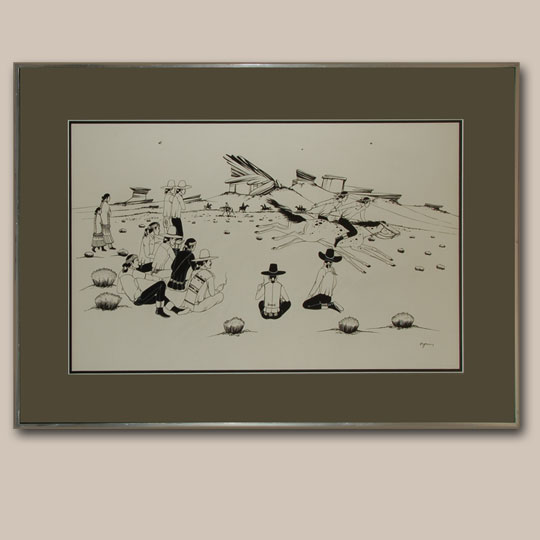 Judging by the paintings we have had at the gallery in the past 15 years, it appears that Beatien Yazz produced very few black on white paintings. In this painting, he portrays two young Navajo boys horse racing to the pleasure of the group of adults sitting around watching. In the background are more horses and riders.
Judging by the paintings we have had at the gallery in the past 15 years, it appears that Beatien Yazz produced very few black on white paintings. In this painting, he portrays two young Navajo boys horse racing to the pleasure of the group of adults sitting around watching. In the background are more horses and riders.
The black pigment used in this rendering is very strong, producing a good contrast with the white background. His treatment of the rock formations in the far background is very modern in concept, something a little different from past paintings.
Acoma Pueblo Polychrome Design Jar - C3819B
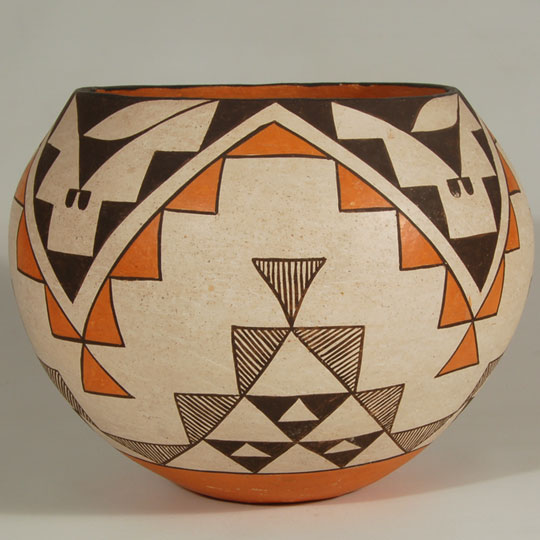 Pottery has always been a central feature of the pueblo people, both for ceremonial and utilitarian purposes. Everything about the daily lives of the pueblo people is of a religious nature. They do not look at jars such as this one as an "art object" as we do. To them, it is a utilitarian vessel or in some cases a ceremonial vessel. The fact that it is beautifully decorated is accepted as part of their history and their lives. Pottery is a sacred part of daily life.
Pottery has always been a central feature of the pueblo people, both for ceremonial and utilitarian purposes. Everything about the daily lives of the pueblo people is of a religious nature. They do not look at jars such as this one as an "art object" as we do. To them, it is a utilitarian vessel or in some cases a ceremonial vessel. The fact that it is beautifully decorated is accepted as part of their history and their lives. Pottery is a sacred part of daily life.
Whether a jar was made for use by the potter in her home or whether it was made for sale to a tourist visiting the pueblo is of no consequence. What are important to collectors are age, condition and beauty. Also important to Acoma potters is that potsherds of prehistoric or historic or even contemporary pottery are ground up and added to the clay for making a new pot. Every Acoma pot contains some part of an older pot. This provides a continuum to the two-thousand-year history of Acoma pottery.
Acoma Pueblo Polychrome Bowl signed Leno by Juana Leno - C3819D
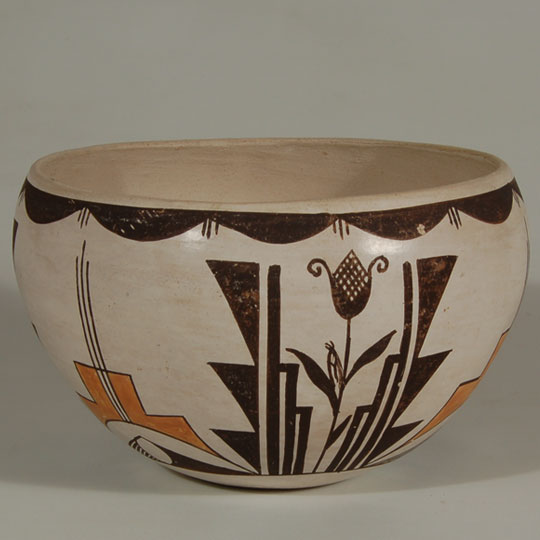 Juana Leno was one of the most accomplished potters at Acoma Pueblo in the 20th century. For the most part, she was unequalled. Her work was flawless. Of all the potters from Acoma whom I personally knew, she was my favorite. She quietly worked every day producing extraordinary pottery without seeking acclaim. She was a wonderful woman and very modest about her talent to produce such fine pieces. She may not have achieved the fame she was due, but it was not because of the lack of quality in her work, but because she chose to remain quietly at home and not seek fame.
Juana Leno was one of the most accomplished potters at Acoma Pueblo in the 20th century. For the most part, she was unequalled. Her work was flawless. Of all the potters from Acoma whom I personally knew, she was my favorite. She quietly worked every day producing extraordinary pottery without seeking acclaim. She was a wonderful woman and very modest about her talent to produce such fine pieces. She may not have achieved the fame she was due, but it was not because of the lack of quality in her work, but because she chose to remain quietly at home and not seek fame.
Wood Carving in the Likeness of a Squash Katsina - C3805E
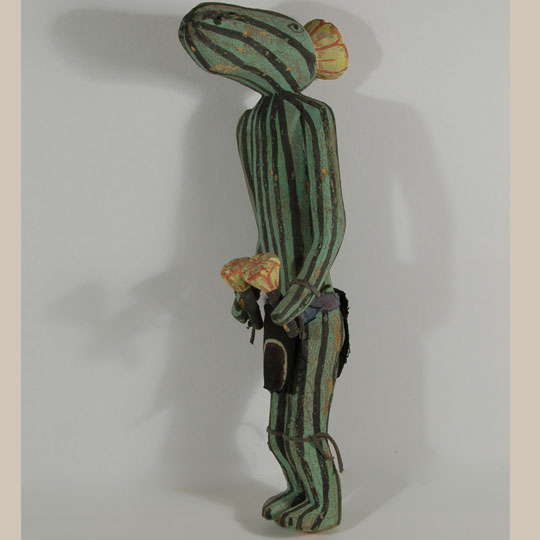 A number of years ago, it was noticed that a quantity of wood carvings began to appear that looked like authentic Hopi Katsina dolls, but they were not true to scale or style. It was determined that someone in Arizona, not a Hopi, was making these and distressing them to look like old katsina dolls.
A number of years ago, it was noticed that a quantity of wood carvings began to appear that looked like authentic Hopi Katsina dolls, but they were not true to scale or style. It was determined that someone in Arizona, not a Hopi, was making these and distressing them to look like old katsina dolls.
I am convinced that this Squash carving is one of those. It is too long and skinny and has been distressed to appear old.
Hopi Pueblo Night Dance Panorama with Kasinas by Watson Namoki - C3383ZS
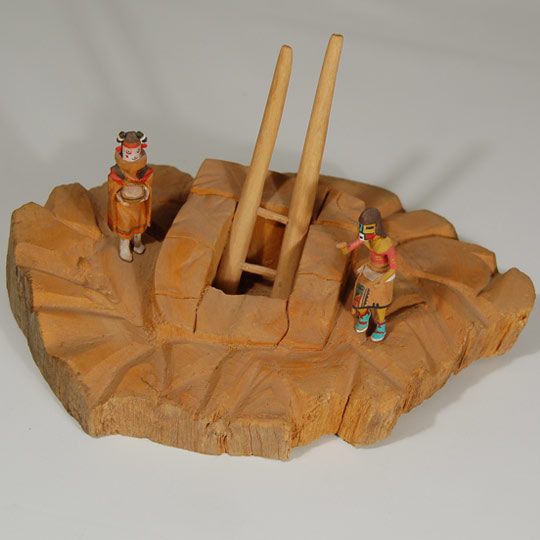 Watson Namoki has created a kiva scene with a ladder inserted from the roof top into the inside. On the roof, he placed Hahai-i Wuhti Katsina carrying a bowl of blue cornmeal and Tuma-uyi (White Chin) Katsina in a panorama of a Katsina Night Dance.
Watson Namoki has created a kiva scene with a ladder inserted from the roof top into the inside. On the roof, he placed Hahai-i Wuhti Katsina carrying a bowl of blue cornmeal and Tuma-uyi (White Chin) Katsina in a panorama of a Katsina Night Dance.
Hahai-i Wuhti is considered to be a sprightly Hopi grandmother. Whenever she appears she is usually very vocal, an attribute not common among the other katsinas. She is considered the mother of the Ogre Katsinas as well as the mother of all katsinas. Tuma-uyi Katsina is one of the very old katsinas. When he appears, he comes in a group, but can be impersonated at any time. His name means "white chin" and seems to derive from the white clay (kaolin) that is used to coat katsina dolls before they are painted.
Ohkay Owingeh - San Juan Pueblo Historic Large Black Storage Jar - SC3816B
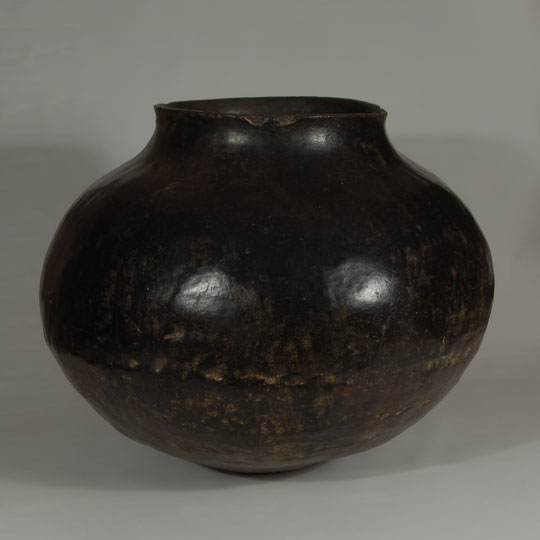 The arrival of the Spaniards in the late 1500s had very little effect on pottery production at the pueblos in either shape or design, but by the 1700s, there were noticeable changes. Still later, with the opening of the Santa Fe Trail in 1821 and the arrival of the transcontinental railroad in 1880, change became inevitable at pueblos located close to the non-Indian populations.
The arrival of the Spaniards in the late 1500s had very little effect on pottery production at the pueblos in either shape or design, but by the 1700s, there were noticeable changes. Still later, with the opening of the Santa Fe Trail in 1821 and the arrival of the transcontinental railroad in 1880, change became inevitable at pueblos located close to the non-Indian populations.
San Juan Pueblo is located only 6 miles from Espanola, New Mexico, and was the area chosen by the Spaniards as the first capitol of their northern territory. They eventually relocated their headquarters to Santa Fe. Even though San Juan was near a population center, there was very little, if any, effect on its pottery styles. The only effect was its almost complete cessation in the late 1800s, however, what little was produced stayed the same until the 1930s when change eventually appeared for commercial purposes.
Tesuque Pueblo Original Painting of a Snake Dancer by Tomás Vigil - C3437G
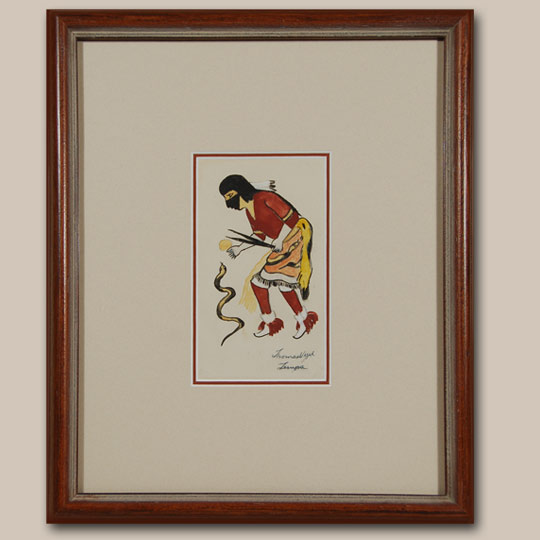 It can be said that Tomás Vigil (Pan-Yo-Pin - Summer Mountain) was of the style of most early 20th century pueblo paintings-that is it was simple, two-dimensional painting. He outlined his intention in pencil before beginning to paint. His colors are strong and show much contrast. His figures generally show considerable action.
It can be said that Tomás Vigil (Pan-Yo-Pin - Summer Mountain) was of the style of most early 20th century pueblo paintings-that is it was simple, two-dimensional painting. He outlined his intention in pencil before beginning to paint. His colors are strong and show much contrast. His figures generally show considerable action.
He signed his paintings with this name Pan-yo-Pin (1889-1960). He was from Tesuque Pueblo and passed away before the resurgence in Native art occurred in the 1960s, with strong interest witnessed in the 1980s and again in 2005. This interest continues today but works of many artists who passed away around the mid-20th century are not often seen because many of those purchases were not considered important and were not sufficiently protected. Fortunately, this one by Pan-yo-Pin survived.

